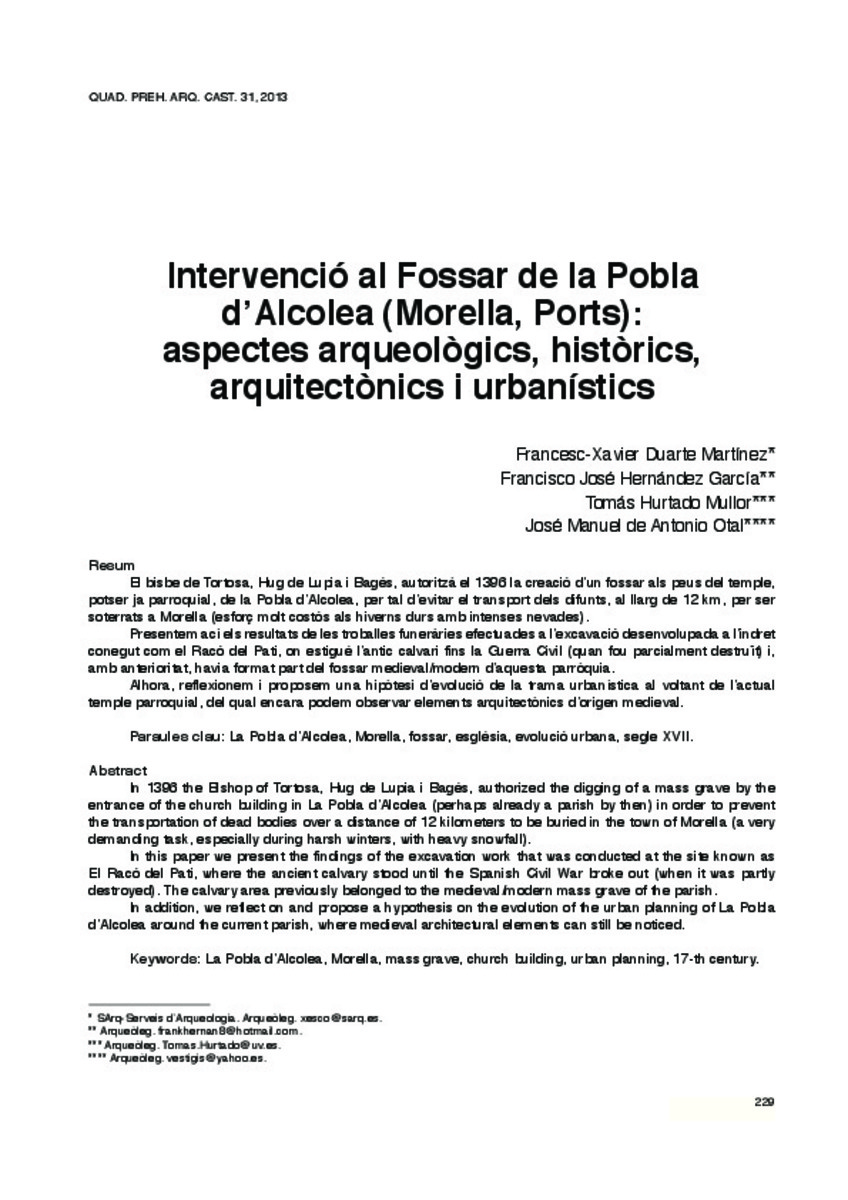Mostrar el registro sencillo del ítem
Intervenció al Fossar de la Pobla d’Alcolea (Morella, Ports): aspectes arqueològics, històrics, arquitectònics i urbanístics
| dc.contributor.author | Duarte Martínez, Francesc Xavier | |
| dc.contributor.author | Hernández García, Francisco José | |
| dc.contributor.author | Hurtado, Tomás | |
| dc.contributor.author | de Antonio Otal, José Manuel | |
| dc.date.accessioned | 2014-02-20T18:15:46Z | |
| dc.date.available | 2014-02-20T18:15:46Z | |
| dc.date.issued | 2013 | |
| dc.identifier.citation | Duarte Martínez, Francesc-Xavier;Hernández García, Francisco José;Hurtado Mullor, Tomás;Antonio Otal, José Manuel de.Intervenció al Fossar de la Pobla d’Alcolea (Morella, Ports): aspectes arqueològics, històrics, arquitectònics i urbanístics.Quaderns de prehistòria i arqueologia de Castelló, 2013, núm.31, p.229-254 | ca_CA |
| dc.identifier.issn | 1137-0793 | |
| dc.identifier.uri | http://hdl.handle.net/10234/84412 | |
| dc.description.abstract | El bisbe de Tortosa, Hug de Lupia i Bagés, autoritzà el 1396 la creació d’un fossar als peus del temple, potser ja parroquial, de la Pobla d’Alcolea, per tal d’evitar el transport dels difunts, al llarg de 12 km, per ser soterrats a Morella (esforç molt costós als hiverns durs amb intenses nevades). Presentem ací els resultats de les troballes funeràries efectuades a l’excavació desenvolupada a l’indret conegut com el Racó del Pati, on estigué l’antic calvari fins la Guerra Civil (quan fou parcialment destruït) i, amb anterioritat, havia format part del fossar medieval/modern d’aquesta parròquia. Alhora, reflexionem i proposem una hipòtesi d’evolució de la trama urbanística al voltant de l’actual temple parroquial, del qual encara podem observar elements arquitectònics d’origen medieval. | ca_CA |
| dc.description.abstract | In 1396 the Bishop of Tortosa, Hug de Lupia i Bagés, authorized the digging of a mass grave by the entrance of the church building in La Pobla d’Alcolea (perhaps already a parish by then) in order to prevent the transportation of dead bodies over a distance of 12 kilometers to be buried in the town of Morella (a very demanding task, especially during harsh winters, with heavy snowfall). In this paper we present the findings of the excavation work that was conducted at the site known as El Racó del Pati, where the ancient calvary stood until the Spanish Civil War broke out (when it was partly destroyed). The calvary area previously belonged to the medieval/modern mass grave of the parish. In addition, we reflect on and propose a hypothesis on the evolution of the urban planning of La Pobla d’Alcolea around the current parish, where medieval architectural elements can still be noticed. | ca_CA |
| dc.format.extent | 26 p. | ca_CA |
| dc.format.mimetype | application/pdf | ca_CA |
| dc.language.iso | cat | ca_CA |
| dc.publisher | Diputació de Castelló: Servei d'Investigacions Arqueològiques i Prehistòriques | ca_CA |
| dc.rights.uri | http://rightsstatements.org/vocab/CNE/1.0/ | * |
| dc.subject | Prehistòria | ca_CA |
| dc.subject | La Pobla d’Alcolea | ca_CA |
| dc.subject | Morella | ca_CA |
| dc.subject | Fossar | ca_CA |
| dc.subject | Església | ca_CA |
| dc.subject | Evolució urbana | ca_CA |
| dc.subject | Segle XVII | ca_CA |
| dc.subject | Mass grave | ca_CA |
| dc.subject | Church building | ca_CA |
| dc.subject | Urban planning | ca_CA |
| dc.subject | 17-th century | ca_CA |
| dc.subject.other | Prehistòria -- Revistes | ca_CA |
| dc.subject.other | Castelló (Comunitat Valenciana) -- Arqueologia -- Revistes | ca_CA |
| dc.title | Intervenció al Fossar de la Pobla d’Alcolea (Morella, Ports): aspectes arqueològics, històrics, arquitectònics i urbanístics | ca_CA |
| dc.type | info:eu-repo/semantics/article | ca_CA |
| dc.rights.accessRights | info:eu-repo/semantics/openAccess | ca_CA |
Ficheros en el ítem
Este ítem aparece en la(s) siguiente(s) colección(ones)
-
Any 2013 - Núm. 31 [20]







